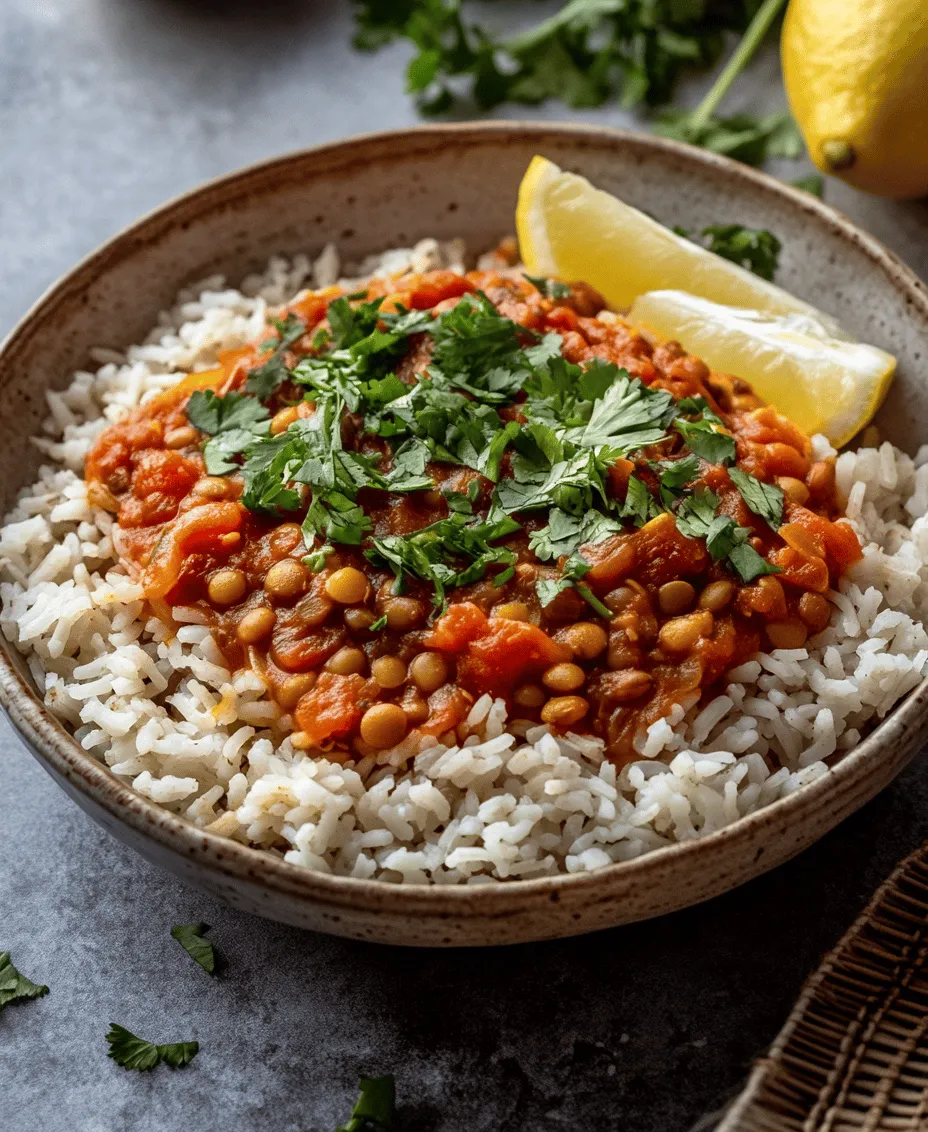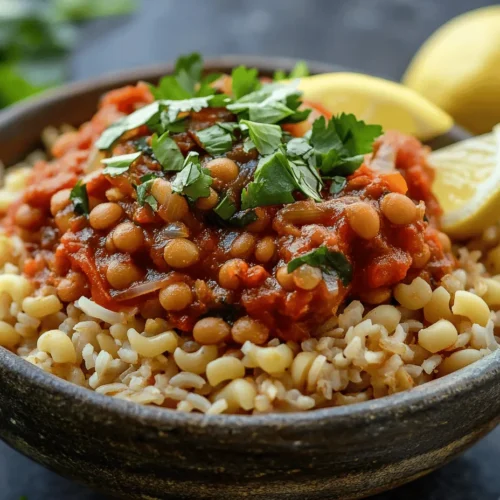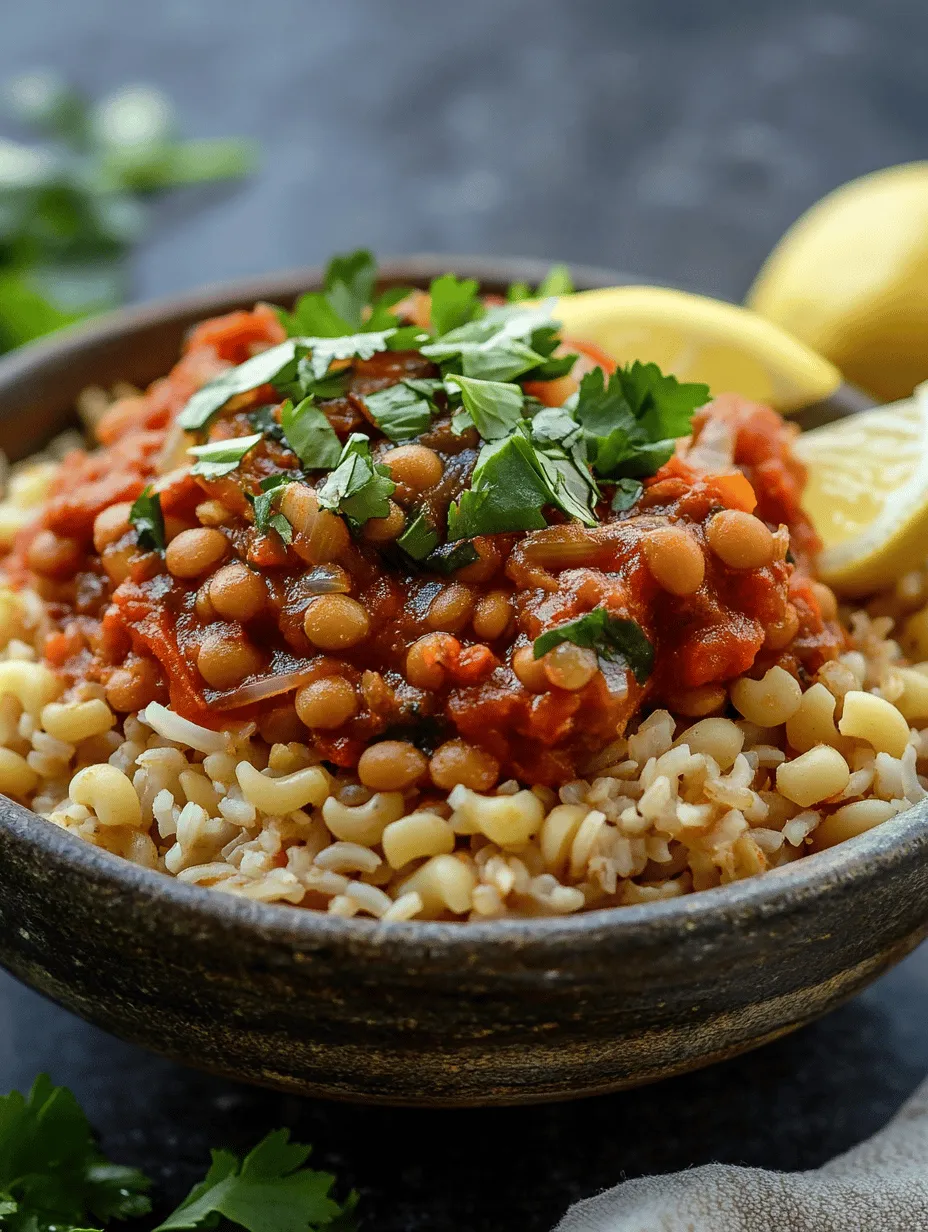Introduction
Koshari is a beloved dish that holds a special place in the hearts of Egyptians and is often regarded as the national dish of Egypt. This hearty, flavorful mix of rice, lentils, and pasta topped with a rich tomato sauce and crispy onions is not only a staple of Egyptian street food but also a homemade favorite. Koshari is celebrated for its ability to bring people together, serving as a comforting meal that nourishes both body and soul. It’s a dish that reflects the rich tapestry of Egyptian culture, blending various ingredients into a single bowl of deliciousness.
The significance of Koshari in Egyptian cuisine extends beyond its taste; it represents resilience and resourcefulness, as it originated as a way to create a filling meal using affordable, readily available ingredients. The dish is not only economical but also packed with nutrition, making it a wholesome choice for families. The combination of lentils, rice, and pasta provides a satisfying balance of carbohydrates and protein, all while being complemented by a medley of spices that enhance its flavor profile.
As we delve deeper into the world of Koshari, we will explore its historical roots, the evolution of this iconic dish over the years, and the nutritional benefits of its wholesome ingredients.
Understanding Koshari
Historical Background of Koshari in Egyptian Cuisine
The origins of Koshari can be traced back to the 19th century, during the British occupation of Egypt. It is believed that Koshari was influenced by the diverse culinary traditions brought by different cultures, including Indian and Italian cuisines. The dish was initially made with rice and lentils, and it was later adapted by incorporating pasta, which became a staple component. Over time, Koshari evolved into the dish we know today, showcasing Egypt’s rich history and the fusion of flavors from various cultures.
Koshari is not merely a meal; it is a culinary emblem of Egypt’s social fabric. Historically, it was consumed by the working class due to its affordability and ease of preparation, making it a popular choice among street vendors. Today, Koshari is enjoyed by Egyptians from all walks of life, often served in homes and restaurants alike, symbolizing comfort and nostalgia for many.
Evolution of Koshari Through the Years
As Egypt has undergone transformations over the decades, so has Koshari. The dish has adapted to changing tastes and lifestyles while remaining a beloved staple. In contemporary Egypt, Koshari can be found in various forms, with some vendors offering gourmet versions that include unique toppings or variations in sauce. The traditional preparation, however, remains cherished by many, reflecting the enduring legacy of this humble dish.
Koshari has also gained international recognition, prompting food enthusiasts to explore its flavors outside of Egypt. Its rise to fame has led to a greater appreciation of Egyptian cuisine as a whole, paving the way for more dishes to take center stage on the global culinary map.
Koshari as a Symbol of Comfort Food in Egypt
For many Egyptians, Koshari represents more than just a meal; it is a symbol of comfort and home. It evokes memories of family gatherings, shared dinners, and street food experiences that resonate with nostalgia. The simple act of preparing Koshari can bring families together, as it often requires teamwork — from cooking the lentils and rice to frying the onions.
Moreover, Koshari is often associated with celebrations and communal gatherings, highlighting its role as a unifying dish. It is common to see Koshari served at weddings, festivals, and other significant occasions, further solidifying its status as a cherished part of Egyptian culture.
Ingredients Breakdown
To create a delicious Koshari, it’s essential to understand the components that make this dish both satisfying and nutritious. Here’s a detailed look at each ingredient that contributes to the unique flavor and texture of Koshari.
Lentils
Lentils are a cornerstone of Koshari, providing both protein and fiber. The most commonly used lentils in Koshari are brown or black lentils, which hold their shape well during cooking and add a hearty texture to the dish. Lentils are rich in essential nutrients, including iron, folate, and magnesium, making them a healthy addition to any meal. They are also known for their ability to keep you feeling full, which is one reason Koshari is such a filling dish.
Rice
Long-grain rice, particularly Egyptian rice, is preferred for Koshari due to its fluffy texture and ability to absorb flavors. The rice acts as the base of the dish, providing a satisfying foundation that complements the other ingredients. It is important to select high-quality rice to ensure that it cooks evenly and maintains its structure when combined with lentils and pasta.
Elbow Macaroni
Elbow macaroni adds a unique twist to Koshari, contributing to its distinctive texture. The pasta not only enhances the dish’s visual appeal but also provides additional carbohydrates, making Koshari a hearty meal. While traditional recipes often call for elbow macaroni, variations may include other pasta shapes, allowing for different textures and flavors.
Onions and Garlic
Onions and garlic are key flavor enhancers in Koshari. Caramelized onions add a sweet, savory depth to the dish, while garlic infuses it with aromatic richness. Together, they create a fragrant base that elevates the overall flavor profile of Koshari. The crispy fried onions on top serve as a delightful garnish, adding a satisfying crunch.
Spices
The spice blend used in Koshari is essential for achieving its signature taste. Common spices include cumin, coriander, paprika, and cayenne pepper. Cumin and coriander provide warm, earthy notes, while paprika adds a subtle smokiness. Cayenne pepper introduces a hint of heat, which can be adjusted according to personal preference. The careful balance of these spices transforms Koshari into a flavorful dish that tantalizes the taste buds.
Vegetable Broth vs. Water
When cooking the rice and lentils, you may choose to use vegetable broth instead of water to enhance the flavor of the dish. Vegetable broth infuses the grains and legumes with additional depth, making each bite more flavorful. If you opt for water, consider adding extra spices or aromatics to compensate for the lack of broth.
Garnishes
The final touch to a bowl of Koshari is the garnish. Fresh herbs, such as parsley or cilantro, can brighten the dish and add a pop of color. A squeeze of lemon juice is also essential, as it brings acidity that balances the richness of the lentils and pasta. These garnishes not only enhance the presentation but also elevate the overall flavor profile.
Preparation Steps
Now that we have a solid understanding of the ingredients, let’s move on to the preparation steps that will guide you in creating the perfect Koshari at home.
Cooking the Lentils
To begin, it’s important to rinse and soak the lentils to remove any impurities and ensure even cooking. Rinse the lentils under cold water until the water runs clear, then soak them for about 30 minutes. This soaking process helps soften the lentils, reducing cooking time and enhancing their texture.
Once soaked, drain the lentils and place them in a pot. Cover the lentils with water or vegetable broth, using a ratio of approximately 1 part lentils to 2 parts liquid. Bring the mixture to a boil, then reduce the heat to a simmer. Cook the lentils for about 20-25 minutes, or until they are tender but not mushy. Keep an eye on the pot and stir occasionally to prevent sticking.
Cooking Tips for Perfect Lentils
To achieve the best results, avoid adding salt to the lentils while they are cooking, as this can make them tough. Instead, season them once they are tender. Additionally, taste the lentils for doneness, as cooking times may vary depending on the type and age of the lentils used.
Preparing the Rice
While the lentils cook, you can prepare the rice. Begin by rinsing the rice under cold water until the water runs clear. This step removes excess starch, preventing the rice from becoming sticky. After rinsing, soak the rice for about 15-20 minutes before cooking.
To cook the rice, heat a tablespoon of oil in a pot over medium heat. Once the oil is hot, add the rinsed and drained rice. Toast the rice for a few minutes, stirring frequently until it becomes slightly golden and fragrant. This toasting technique adds a nutty flavor to the rice.
Next, add the appropriate amount of water or vegetable broth to the pot, typically using a 2:1 ratio of liquid to rice. Bring the mixture to a boil, then reduce the heat to low, cover the pot, and let it simmer for about 15-20 minutes. Avoid lifting the lid during cooking to ensure even steam distribution.
Importance of the Cooking Liquid and Timing
The cooking liquid plays a crucial role in flavoring the rice, so using vegetable broth can enhance the overall taste of Koshari. Timing is also essential — once the rice is cooked, allow it to sit covered for about 5 minutes before fluffing it with a fork. This resting period helps to achieve the perfect texture.
By following these steps, you will lay the foundation for a delicious Koshari that embodies the essence of Egyptian comfort food. As you continue to prepare this cherished dish, you will not only learn about its ingredients and cooking techniques but also appreciate the cultural significance that Koshari holds in the hearts of many.

Cooking the Macaroni
To achieve the perfect texture for the macaroni in your Koshari, bring a large pot of salted water to a rolling boil. The salt is essential as it enhances the flavor of the pasta. Once boiling, add the macaroni and cook according to the package instructions, usually around 7-9 minutes. For Koshari, you want the macaroni to be cooked al dente, which means it should be firm to the bite but not hard.
Al Dente Perfection: How to Achieve It
To ensure that your macaroni reaches that coveted al dente texture, keep a close eye on the cooking time. Start checking the pasta a minute or two before the package’s suggested cooking time. You can do this by tasting a piece; it should be tender but still have a slight firmness in the center. Once the macaroni is ready, drain it in a colander and rinse it briefly under cold water. This stops the cooking process and helps prevent the pasta from sticking together.
Making the Tomato Sauce
The tomato sauce adds a rich, tangy flavor that is essential for a good Koshari. Start by heating a generous amount of olive oil in a medium saucepan over medium heat.
Caramelizing Onions: Techniques for Depth of Flavor
While the oil heats, slice two large onions thinly. Once the oil is shimmering, add the onions and sauté them until they become golden brown and caramelized. This process can take about 10-15 minutes. Stir them frequently to prevent burning, and for added depth of flavor, sprinkle a pinch of salt over the onions as they cook. This will help draw out their moisture and enhance the caramelization.
Layering Spices for a Well-Rounded Sauce
Once the onions are perfectly caramelized, add minced garlic (2-3 cloves) and sauté for another minute until fragrant. Next, introduce spices to the pan: 1 teaspoon of cumin, 1 teaspoon of coriander, and a pinch of red pepper flakes for a touch of heat. Stir these spices into the mixture, allowing them to toast briefly before adding your canned tomatoes (two 14-ounce cans of crushed tomatoes work well).
Stir in 1 teaspoon of sugar to balance the acidity of the tomatoes and season with salt and pepper to taste. Let the sauce simmer for about 15-20 minutes, stirring occasionally until it thickens to your desired consistency.
Assembling the Koshari
Now it’s time to put your Koshari together! The layering of components is crucial for both flavor and presentation.
Step-by-Step Guide to Layering the Components
1. Base Layer: Start with a generous scoop of lentils at the bottom of your serving dish.
2. Add Rice: Next, layer the basmati rice over the lentils, spreading it evenly.
3. Macaroni Layer: Follow with the cooked macaroni, ensuring it covers the rice completely.
4. Tomato Sauce: Spoon a healthy portion of the tomato sauce over the macaroni, allowing it to drizzle down to the lower layers.
5. Chickpeas: Scatter cooked or canned chickpeas on top for added protein and texture.
6. Onion Topping: Finally, top the whole dish with the caramelized onions for a beautiful finish.
Importance of Presentation in Serving Koshari
Presentation plays a significant role in how Koshari is enjoyed. A visually appealing dish enhances the dining experience. Consider serving your Koshari in a large communal bowl, allowing guests to serve themselves. Garnishing with fresh cilantro or parsley can add a pop of color and freshness.
Suggestions for Serving Sizes and Plating
Koshari is a hearty, filling dish, so serving sizes can vary based on the appetite of your guests. Typically, a serving of Koshari can range from 1 to 1.5 cups per person. For plating, use a large spoon to scoop out portions, ensuring every plate receives a balanced mix of rice, lentils, macaroni, and sauce.
Cultural Significance of Koshari
Koshari is more than just a meal; it’s a cultural icon in Egypt.
Koshari in Everyday Egyptian Life
In Egypt, Koshari is a beloved staple, often consumed for lunch or dinner. It’s affordable, filling, and provides a balanced meal that appeals to people from all walks of life. Street vendors commonly feature Koshari on their menus, making it accessible to everyone.
Its Role in Celebrations and Communal Gatherings
During celebrations and communal gatherings, Koshari takes center stage. It’s a dish that brings people together, symbolizing unity and hospitality in Egyptian culture. Serving Koshari at family gatherings or special occasions is a way to honor tradition and share joy among loved ones.
Koshari as a Street Food Staple and Its Popularity Among Locals and Tourists
Koshari is also a popular street food option, with vendors selling it from carts and stalls across Egypt. Its appeal transcends borders, making it a must-try for tourists who want to experience authentic Egyptian cuisine. The dish’s affordability and robust flavors have contributed to its reputation as a beloved comfort food.
Variations and Customizations
Koshari’s versatility allows for numerous variations and customizations.
Vegetarian and Vegan Adaptations
While Koshari is traditionally vegetarian, it can easily be enjoyed by vegans. Simply ensure that the ingredients you use, such as the pasta and sauces, are free from animal products. The dish is already rich in plant-based proteins, thanks to the lentils and chickpeas.
Regional Variations Within Egypt
Different regions of Egypt may have their own twists on Koshari. Some might incorporate specific spices or toppings like fried onions, while others may serve it with a side of spicy vinegar sauce for added flavor. Exploring these regional variations can enhance your understanding of this traditional dish.
Suggestions for Additional Toppings or Sides
To elevate your Koshari experience, consider adding toppings such as crispy fried garlic or additional spices like baharat for a unique twist. Serving Koshari alongside a fresh salad or pickled vegetables can provide a refreshing contrast to the hearty dish.
Health Benefits of Koshari
Koshari is not only delicious but also offers several health benefits.
Nutritional Analysis of the Dish
Each serving of Koshari is packed with carbohydrates, proteins, and essential nutrients. The combination of lentils, rice, and chickpeas offers a complete protein source, making it an excellent meal for vegetarians and vegans.
Benefits of Its Plant-Based Protein Sources
The lentils and chickpeas serve as rich sources of plant-based protein, providing necessary amino acids that support muscle health and overall wellness. These ingredients are also high in fiber, which aids digestion and promotes satiety.
Balancing Carbohydrates and Flavors for a Wholesome Meal
Koshari balances its carbohydrates with a variety of spices, ensuring each bite is not only filling but also bursting with flavor. This balance makes Koshari a wholesome meal that satisfies hunger while providing essential nutrients.
Conclusion
Koshari is a quintessential Egyptian dish that brings together diverse flavors and textures in a harmonious way. Its significance in Egyptian culture is profound, symbolizing community and tradition. This hearty meal is perfect for sharing with family and friends, creating a memorable dining experience filled with warmth and connection.
As you explore the preparation of Koshari in your kitchen, embrace the joy of crafting this traditional dish. Whether enjoyed at home or shared with loved ones, Koshari is a delightful culinary journey that invites you to savor the rich heritage of Egyptian cuisine. So gather your ingredients, follow the steps, and indulge in this delicious, comforting meal that is sure to become a family favorite.



